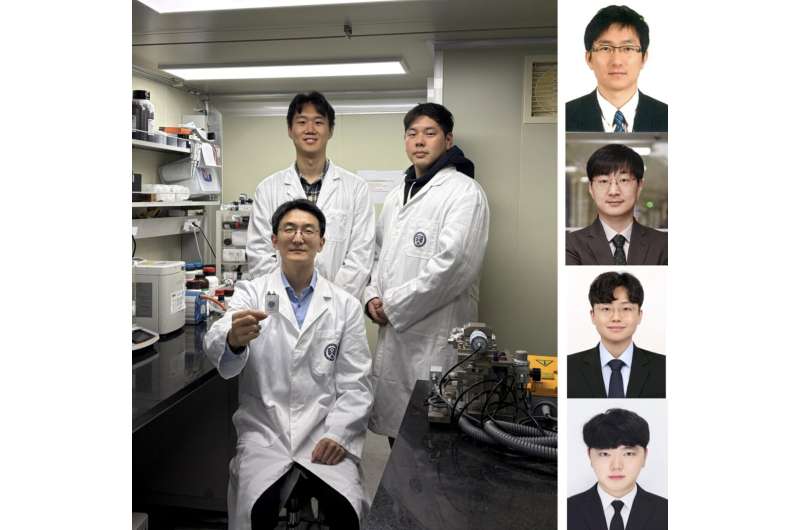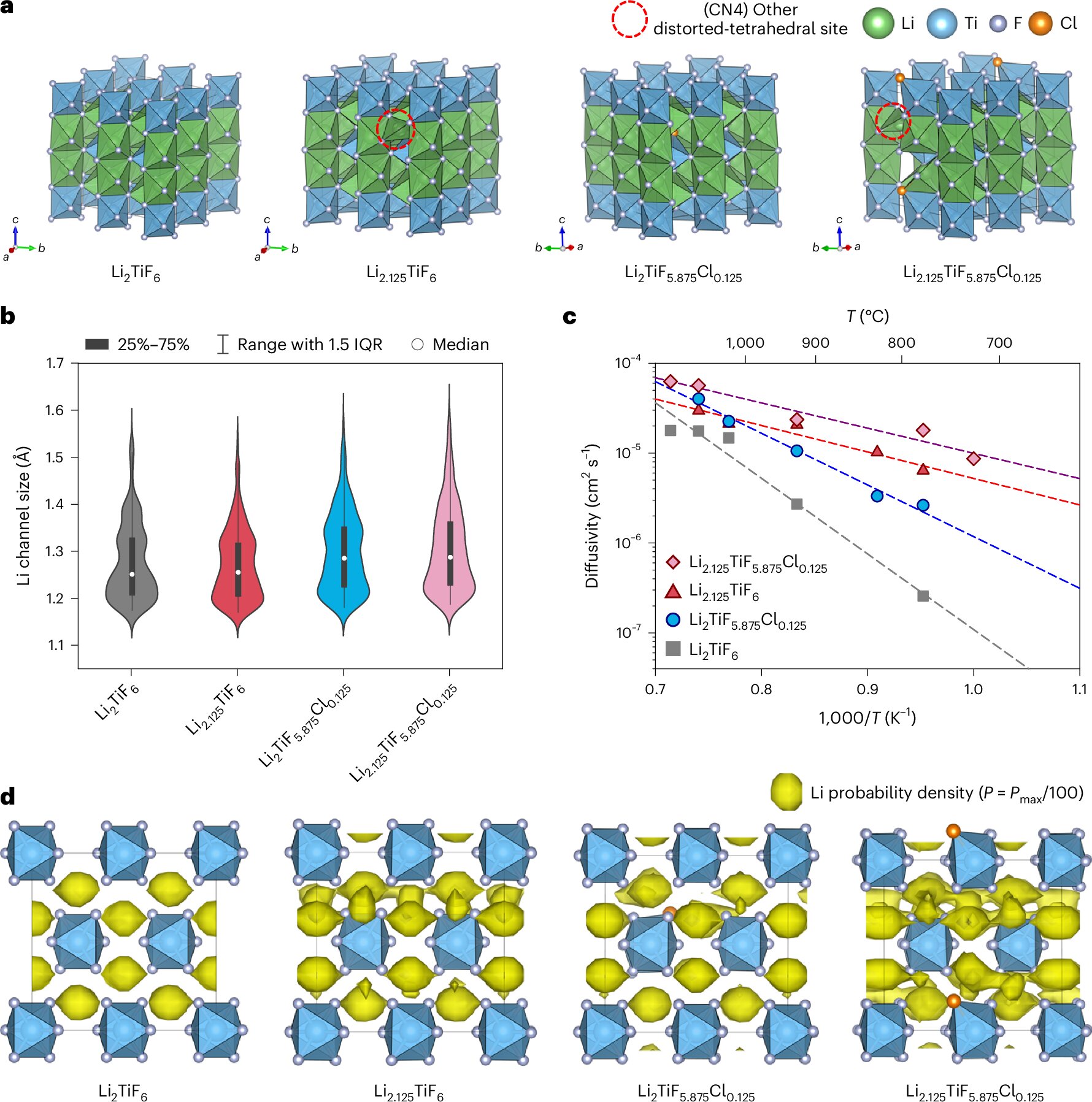All-solid-state batteries (ASSBs) are promising rechargeable batteries in which conventional liquid electrolytes are replaced with solid materials. These batteries could help to safely meet the growing demands of the electronics industry, as they can exhibit high energy densities, yet they should theoretically be safer and more stable than solutions based on flammable liquid electrolytes.
The energy density of most batteries, which is the amount of energy they can store in relation to their weight and volume, is known to depend on various factors, including the voltage of the electrolytes they rely on.
Although liquid electrolytes can operate up to around 4.5 V, their stability rapidly declines beyond this limit. By contrast, solid electrolytes could remain stable at higher voltages, thus allowing batteries to store more energy.
Researchers at Yonsei University, Dongguk University, KAIST and other institutes have designed and synthesized a new fluoride-based solid electrolyte that was found to remain stable at unprecedented voltages above 5 V.
The new electrolyte, introduced in a paper published in Nature Energy, combines lithium chloride (LiCl) with lithium titanium fluoride Li2TiF6.
“This project began with a simple but fundamental question: why not push battery chemistry beyond 5 V?” Yoon Seok Jung, senior author of the paper, told Tech Xplore.
“Increasing the operational voltage is one of the most straightforward ways to enhance energy density, yet we realized that even solid electrolytes in ASSBs were not sufficiently stable at such high voltages. In particular, 5 V spinel cathodes like LiNi0.5Mn1.5O4 had shown poor performance.”
Exploring the potential of fluoride-based solid electrolytes
Recent studies highlighted the promise of chloride-based solid electrolytes for increasing the cycling stability of batteries, particularly when combined with cathode materials based on nickel, cobalt and manganese (namely, NCM) that operate at voltages of 4 V.
Nonetheless, these electrolytes could not be reliably combined with spinel systems, a class of cathodes for Li-ion batteries with a spinel crystal structure that operate at very high voltages (around 5 V).
This ultimately inspired Jung and his colleagues to test the performance of fluoride-based solid electrolytes. While fluoride-based materials have long been recognized for their resistance to oxidation, their potential as solid-state electrolytes has rarely been investigated.
“We wanted to test whether they could truly overcome this hurdle, and the results exceeded our expectations,” explained Jung. “ASSBs replace flammable organic liquid electrolytes with inorganic solid ones, allowing Li+ to move through solid phases instead of liquids.
“This architecture not only improves safety but also enables higher energy density by allowing the use of alternative electrodes such as Li-metal anodes, which are otherwise difficult to employ. However, high-voltage cathodes like spinel materials often trigger the decomposition of conventional solid electrolytes.”
To overcome the challenges typically encountered when combining solid electrolytes with spinel cathode materials, the researchers designed a new electrolyte that has a protective fluoride-based shielding layer. They applied this layer, which is based on the material LiCl–4Li2TiF6, to the surface of a spinel cathode with the composition LiNi0.5Mn1.5O4.
“During its synthesis, this material spontaneously forms a Li-rich interface featuring subtle atomic rearrangements—partial Cl substitution and surface reduction of Ti—that create fast Li+ pathways,” said Jung.
“This combination enables the layer to remain stable at voltages above 5.5 V while maintaining high ionic conductivity. In essence, it protects the interface and ensures smooth ion transport even under extreme operating conditions.”

An electrolyte that yields extraordinary stability
To validate the potential of their newly designed electrolyte, the researchers tested its ability to conduct lithium ions and operate at high voltages. When combined with spinel cathodes, their electrolyte safely and reliably operated at high voltages above 5 V, which was never achieved before using other electrolytes.
“We experimentally demonstrated, for the first time, that 5 V chemistry ¾ including spinel cathodes ¾ can operate successfully in ASSBs when paired with a fluoride-based solid electrolyte,” said Jung.
“This breakthrough overcomes the long-standing 5 V stability barrier. Beyond merely protecting the interface, it opens an entirely new approach to designing high-voltage ASSBs— not only for spinel cathodes, but also for Ni-rich and Li-rich layered oxide materials.”
In the team’s initial tests, a battery employing their new fluoride-based electrolyte with a spinel system attained substantially higher capacity than cells using conventional solid electrolytes, demonstrating robust interfacial stability at high voltages. In addition, the battery was found to retain 75.2% of its capacity after 500 charge and discharge cycles at high voltages.
“We achieved high areal capacities (exceeding 35 mAh cm-2) and demonstrated pouch-cell operation, both of which represent key steps toward practical commercialization,” said Jung.
“Given the recent safety concerns surrounding NCM–sulfide systems, our results suggest that a spinel–fluoride combination could offer a safer yet energy-dense alternative for future electric vehicles and large-scale energy storage applications.”
Next steps towards the advancement of solid-state batteries
This research team’s recent efforts could soon inspire other energy engineers to assess the performance of fluoride-based solid electrolytes. In the future, their electrolyte could contribute to the real-world deployment of high-energy ASSBs, particularly for powering electric vehicles and large electronics.
“Going forward, we are focusing on further increasing the energy density of solid-state batteries by achieving higher mass loading,” said Jung. “The spinel system remains relatively new in the field of ASSBs, leaving much to explore and engineer.”
As part of their next studies, Jung and his colleagues also plan to develop low-cost and high-voltage cathodes that could serve as alternatives to spinel systems. One of these is the cathode LiFe0.5Mn1.5O4, which they recently tested in a solid-state battery for the first time.
“This material is composed of earth-abundant elements yet still delivers high energy density, making it highly attractive from a practical standpoint,” added Jung.
“In parallel, we also wish to explore new fluoride-based solid electrolytes with even higher ionic conductivities. Through these efforts, we hope to contribute to the introduction of next-generation, safe and high-energy ASSBs.”
Written for you by our author Ingrid Fadelli, edited by Sadie Harley, and fact-checked and reviewed by Robert Egan—this article is the result of careful human work. We rely on readers like you to keep independent science journalism alive.
If this reporting matters to you,
please consider a donation (especially monthly).
You’ll get an ad-free account as a thank-you.
More information:
Jun Pyo Son et al, Five-volt-class high-capacity all-solid-state lithium batteries, Nature Energy (2025). DOI: 10.1038/s41560-025-01865-y.
© 2025 Science X Network
Citation:
New electrolyte helps all-solid-state batteries overcome long-standing 5 V stability barrier (2025, November 6)
retrieved 6 November 2025
from https://techxplore.com/news/2025-11-electrolyte-solid-state-batteries-stability.html
This document is subject to copyright. Apart from any fair dealing for the purpose of private study or research, no
part may be reproduced without the written permission. The content is provided for information purposes only.


